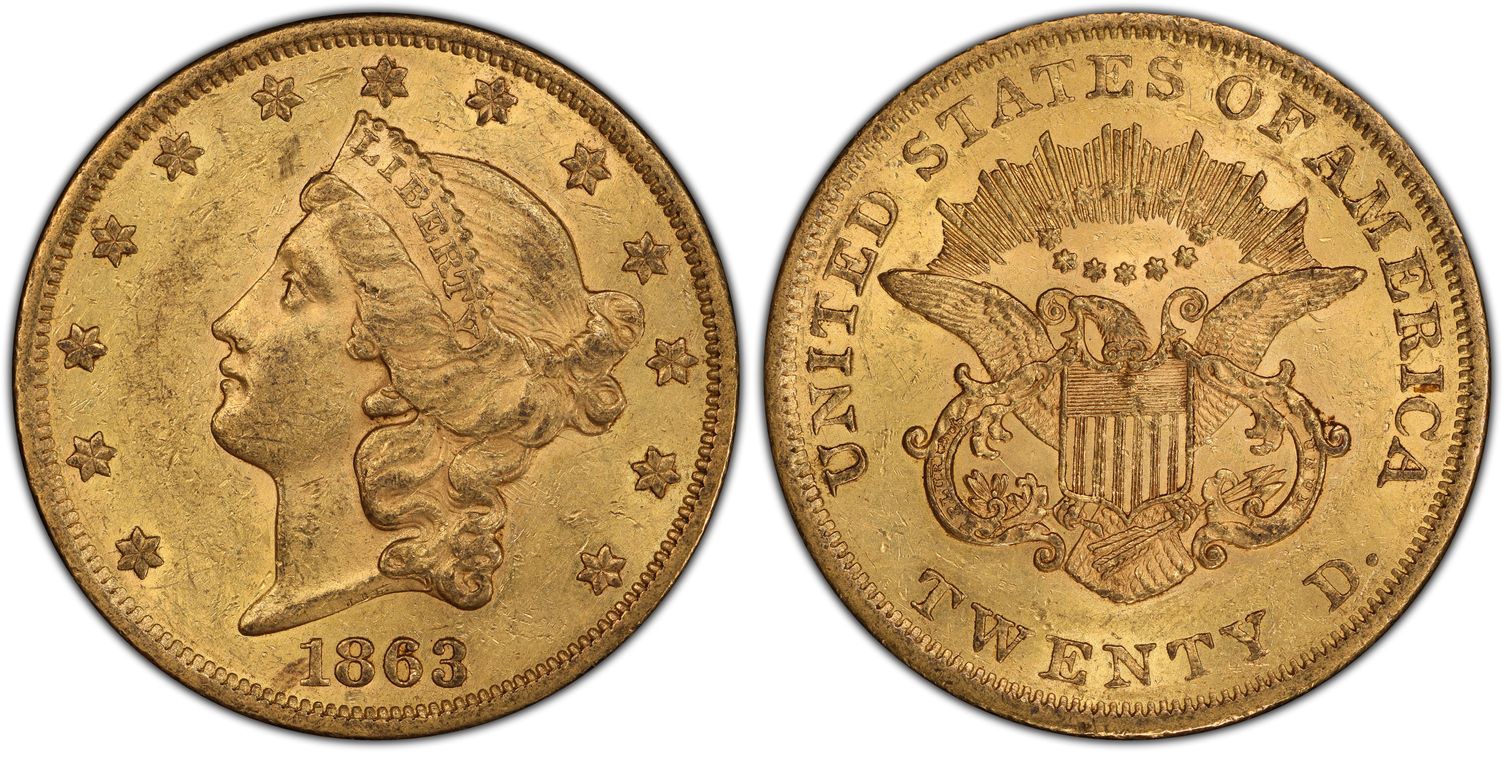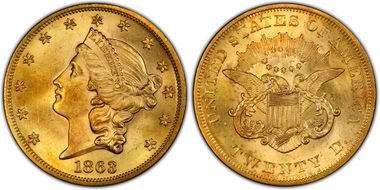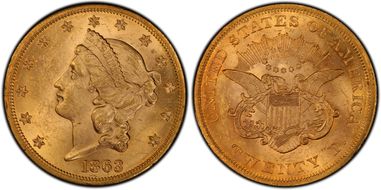1863 $20 MS61 认证号45944699, PCGS号8939
专家评论
Doug Winter
The following information is from my eBook on Type One Liberty Head Double Eagles at http://doubleeaglebook.com/The 1863 remains one of the scarcer Type One double eagles from the Philadelphia mint. It is not easily located in any grade, and it is rare in Uncirculated although not as much so as when the first edition of this book was published in 2002. It used to be nearly as rare as the 1862 in high grades, but the discovery of some Uncirculated examples in the S.S. Republic treasure changed this date’s rarity profile.
STRIKE: The strike seen on the 1863 double eagle varies. There are some examples which are fairly sharp on the hair of Liberty with many of the curls around the face and below the ear showing partial definition. Other examples are weak in this area and do not show as much separation in the curls. Most are sharper than average on the top of the head and the bow knot. The stars are generally sharp with partial to full radial line detail. The reverse may show some weakness on the shield, but most 1863 double eagles have strong peripheral detail on the reverse.
The S.S. Republic coins tend to be better struck than average on both the obverse and the reverse.
SURFACES: Many show extensive abrasions on the surfaces. These marks tend to be deep and placed in prominent focal points such as the cheek of Liberty and in the left obverse field. Many have been cleaned or dipped at one time.
The S.S. Republic coins tend to show much cleaner surfaces. While often abraded in the obverse fields, the high-grade pieces from this source have the cleanest surfaces which I have seen on this date.
LUSTER: Uncleaned, higher grade 1863 business strikes have good frosty luster with a mildly reflective texture. There are a very small number know which are semi-prooflike. It has always been hard to find an example which has not been cleaned or dipped.
The S.S. Republic coins have very good luster and this makes them easily recognizable.
COLORATION: The natural color is a medium to deep yellow-gold. Some show a slightly more orange-gold hue. Not many are known with natural color as most have been cleaned or dipped at one time.
The S.S. Republic coins show nice medium yellow-gold color. While these coins have been conserved by NGC, this was done with consummate skill and the coins have a very pleasing natural appearance.
EYE APPEAL: This date has below average eye appeal. The typical 1863 double eagle is well worn and it shows some weakness on the obverse around the face. Many are noticeably abraded and lack any sense of originality due to having been cleaned or processed. The few choice pieces that are known are held in strong regard, and these sell for strong premiums amongst knowledgeable collectors.
The S.S. Republic coins tend to have well above average eye appeal for this issue, and the majority of CAC-quality 1863 double eagles are from this source.
INTERESTING VARIETIES: There are no significant varieties known.
PROOFS: There were 30 Proofs struck. There are around 10 to 12 known today with at least two or three impounded in museum collections. Most survivors are in the PR63 to PR64 range and show medium to strong cameo contrast.
As of the middle of 2014, PCGS had graded two in PR63, two in PR64, two in PR64CAM, and two in PR64DCAM for a total of eight. NGC had graded two in PR63CAM, two in PR64CAM, one in PR64DCAM, two in PR65CAM, and one in PR66CAM for a total of eight. It is probable that these figures include a number of multiple submissions. CAC has approved one Proof, a PR66CAM.
The auction record for a Proof 1863 double eagle is $381,875 which was set by Heritage 8/14: 5742, graded PR66CAM by NGC.
HOARDS: There were many examples found in the S.S. Republic. The original NGC population figures have changed as coins have been removed from their holders and put into PCGS holders.
BUYING TIPS: This historically significant date is very popular and it has collector appeal outside of the specialist community. Date collectors tend to look either for a nice mid-range AU or they splurge for an impressive Uncirculated example. Be patient and wait for a clean, well struck piece with nice color; these coins are still available and they do not command a huge price premium over a “typical” 1850.
AUCTION RECORD: The auction record for a business strike 1863 double eagle is $76,375 which was set by Stacks Bowers 2014 ANA: 12027.
FINEST KNOWN: The finest known is a single MS64 graded by PCGS. This coin is owned by William Crawford.
RARITY:
TOTAL KNOWN: 350-450
BY GRADE:
Very Fine: 90-100
Extremely Fine: 110-150
About Uncirculated: 125-165
Uncirculated: 25-35
POPULATION FIGURES: As of the beginning of 2015, PCGS had graded two in MS60, six in MS61, eight in MS62, two in MS63, and one in MS64 for a total of 17 in Uncirculated. NGC had graded four in MS60, 10 in MS61, six in MS62, and two in MS63 for a total of 22 in Uncirculated. This includes 16 coins from the S.S. Republic. These figures are inflated by resubmissions, especially in MS61 and MS62. CAC has approved three Uncirculated examples, all graded MS61.
PERFORMANCE SINCE 2002: In the current market, a choice About Uncirculated example of this date (equivalent to an AU55) would sell in the $16,000-19,000 range. The same coin in 2002 would have sold for $6,000-8,000. In the current market, an average quality Uncirculated example of this date (equivalent to an MS61) would sell in the $30,000-35,000 range. It is hard to determine what this coin would have sold for in 2002 given the rarity of this issue at that time; my best estimate is in the $15,000-20,000 range. This date has performed well in the last decade, and clearly the S.S. Republic hoard has in fact helped this date rather than depressed its prices as some thought it would.
COMMENTS: Perhaps no other rare date Type One double eagle had its profile changed as much as the 1864 since the publication of the first edition of this book. This is the result of the discovery of hundreds of pieces on the S.S. Republic which were graded About Uncirculated and Uncirculated by NGC. The examples from this source which are now in PCGS holders (often at grades higher than their original level) are not indicted on the holder, but are easy to attribute due to their appearance.
David Akers (1975/88)
As a date, the 1863 is not quite as rare as the 1862 but it is even more rare than the 1862 in high grade. In terms of overall rarity, I put the 1863 on the same level as such dates as the 1855, 1856, 1857, 1858 and 1864 among others.PCGS #
8939
设计师
James Barton Longacre
边缘
Reeded
直径
34.00 毫米
重量
33.40 克
铸币数量
142790
金属成分
90% Gold, 10% Copper
更高评级数量
13
评级较低的钱币数量
175
地区
The United States of America
价格指南
PCGS 数量报告
拍卖 - PCGS 评级的
拍卖 - NGC 评级的
稀有性和存量估计 了解更多
| 所有评级 | 427 |
| 60或以上 | 35 |
| 65或以上 | 0 |
| 所有评级 | R-6.1 |
| 60或以上 | R-8.8 |
| 65或以上 | R-10.1 |
| 所有评级 | 16 / 44 |
| 60或以上 | 23 / 44 TIE |
| 65或以上 | 1 / 44 |
| 所有评级 | 27 / 148 TIE |
| 60或以上 | 41 / 148 TIE |
| 65或以上 | 1 / 148 |






















